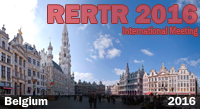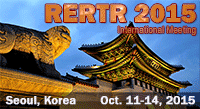 2007 International RERTR Meeting
2007 International RERTR Meeting
Abstracts and Available Papers Presented at the Meeting
Tc-99m Generators for Clinical Use Based on Zirconium Molybdate Gel and (n,γ) Produced Mo- 99: Indian Experience in the Development and Deployment of Indigenous Technology and Processing Facilities
P. Saraswathy, A.C. Dey,
S.K. Sarkar, C. Kothalkar, P. Naskar, G. Arjun, S.S.
Arora and A.K.Kohli
Board of Radiation and Isotope Technology (BRIT), BARC
Vashi Complex,
Navi Mumbai, India 400705
V. Meera and
V.Venugopal
Radiochemistry & Isotope Group, Bhabha Atomic Research
Centre (BARC),
Mumbai, India 400085
N.Ramamoorthy *
Division of Physical and Chemical Sciences,
International Atomic Energy Agency (IAEA),
A- 1400, Vienna, Austria
ABSTRACT
The Indian pursuit of gel generator technology for 99mTc was driven mainly by three considerations, namely, (i) well-established and ease of reliable production of (n, gamma)-based 99Mo in several tens of GBq quantities in the research reactors in Trombay/Mumbai, India, (ii) need for relatively low-cost alternate technology to replace the solvent (MEK) extraction generator system in use in India since 1970s and (iii) minimize dependency on weekly import of fission-produced 99Mo raw material required for alumina column generator. Extensive investigations on process standardisation for zirconium molybdate gel (ZMG) led to a steady progress, achieved both in terms of process technology and final performance of 99mTc gel generators. The 99mTc final product purity from the Indian gel system was comparable to that obtained from the gold-standard alumina column generators. Based on the feasibility established for reliable small-scale production, as well as satisfactory clinical experience with a number of gel generators used in collaborating hospital radiopharmacies, full-fledged mechanised processing facilities for handling up to 150 g of ZMG were set up. The indigenous design and development included setting up of shielded plant facilities with pneumatic-driven as well as manual controls and special gadgets such as, microwave heating of the zirconium molybdate cake, dispenser for gel granules, loading of gel columns into pre-assembled generator housing etc. Formal review of the safety features was carried out by the regulatory body and stage-wise clearance for processing low and medium level 99Mo activity was granted. Starting from around 70 GBq 99Mo handling, the processing facilities have since been successfully operated at a level of 740 GBq 99Mo, twice a month. In all 18 batches of gel have been processed and 156 generators produced. The individual generator capacity was 15 to 30 GBq with an elution yield of nearly 75%. 129 generators were supplied to 11 user hospitals and the estimated number of clinical studies done is well over 5000. The salient aspects of the Indian experience have been reported in many a forum and shared with the IAEA through the on-going CRP. The detailed process know-how is available for technology transfer from BRIT, India.
* since October 2003, Director of the Division of Physical and Chemical Sciences of the IAEA
![]() Full paper in PDF format
Full paper in PDF format
IMPORTANT NOTE:
Download the latest and free version of
Adobe's
Reader to view documents in PDF format. If you have questions about
or problems with downloading, installing or using Adobe's Reader, please visit the
Adobe
website.
![]()
Problems viewing/ printing PDF files
Should you experience problems with viewing/printing the PDF files:
![]() PDF Help Notes (link opens in new browser
window)
PDF Help Notes (link opens in new browser
window)
Contact:
Dr. Jordi Roglans-Ribas
Technical Director, RERTR Department
Nuclear Engineering Division – 362
Argonne National Laboratory
9700 South Cass Avenue
Argonne, IL 60439
Fax: +1 630-252-5161
![]()




